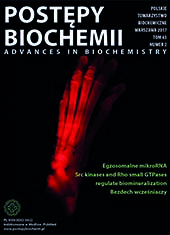Influence of conjugated linoleic acids on metabolic processes in cells and tissues
Abstract
Conjugated linoleic acids (CLA) are constitutional and geometric isomers of this acid. The most commonly consumed geometric isomers are cis-9,trans-11 (c9, t11) CLA and trans-10, cis-12 (t10,c12) CLA. These isomers together with trans-9,trans-11 CLA and trans-10,trans-12 CLA constitute about 90% of all CLA in natural products. Different structure of the isomers affects their functions in the body. Differences in the effects on organs and tissues are sometimes small and sometimes opposed, sometimes the isomers work synergistically. Diverse influence has been shown mainly in neoplastic processes and lipid metabolism. For example, differences in inhibition of proliferation of prostate cancer cells are explained by different pathways: t10,c12 CLA acts on apoptosis and cell cycle control genes, while c9,t11 CLA regulates genes involved in metabolism of arachidonic acid with subsequent impairment of eicosanoids synthesis. Other studies have shown that t10,c12 CLA, but not c9,t11 CLA, can induce fat reduction in adipose tissue and apoptosis of adipocytes in mice.
Downloads
Published
Issue
Section
License
All journal contents are distributed under the Creative Commons Attribution-ShareAlike 4.0 International (CC BY-SA 4.0) license. Everybody may use the content following terms: Attribution — You must give appropriate credit, provide a link to the license, and indicate if changes were made, ShareAlike — If you remix, transform, or build upon the material, you must distribute your contributions under the same license as the original. There are no additional restrictions — You may not apply legal terms or technological measures that legally restrict others from doing anything the license permits.
Copyright for all published papers © stays with the authors.
Copyright for the journal: © Polish Biochemical Society.




